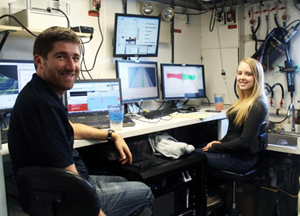
Dr. Ian Church trains Lauren to operate the Multibeam on the R/V Point Sur during the first leg of the CONCORDE Fall Campaign. (Photo credit: Heather Dippold)
Oil droplets can attach to tiny sediment particles suspended in the water column, causing them to sink to the seafloor where they can linger for a long time. Sediment grain size influences if and how oil droplets are resuspended into the water column. Larger particles sink faster and are more difficult to resuspend in the water column than smaller particles.
Lauren Quas uses acoustic sonar to map different sediment grain sizes and help understand and predict the behavior of oil in seafloor sediments. Knowing where different grain sizes are concentrated in the northern Gulf of Mexico seafloor can help scientists evaluate resuspension rates in those areas and estimate where oil might end up.
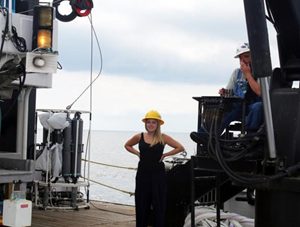
Lauren and Chief Engineer Joshua Jansen supervise the lowering of the multibeam pole into the water. (Photo credit: Alison Deary, Carla Culpepper, and Kelia Axler)
Lauren Quas is a master’s student in the University of Southern Mississippi’s Hydrographic Science program and a GoMRI Scholar with the Consortium for Oil Spill Exposure Pathways in Coastal River-Dominated Ecosystems (CONCORDE).
Her Path
As a child, Lauren loved being outdoors and collecting rocks and seashells. Her family’s vacations often involved trips to the beach, which sparked her love for the ocean. Encouraged by her parents to see the world, Lauren spent almost a decade during her high school and college years visiting countries in nearly every continent on the globe. No matter where she went, she found that the landscapes and coastlines were the most awe-inspiring parts of her travels. “It is in these places that you realize how small we are as humans and yet how big our impact is on the world,” she said.
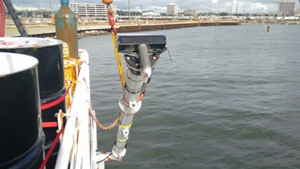
The multibeam sonar attached to the pole mount off the side of the R/V Point Sur. (Photo credit: Ian Church)
While completing her bachelor’s degree in geology at the University of Memphis, Lauren interned at the University of Memphis Groundwater Institute conducting visual stream measurements. Knowing that she wanted to pursue a career that would combine her passion for adventure and travel with her love for the ocean, she enrolled in the University of Southern Mississippi’s Geological Oceanography program. She switched her major to hydrographic science after working with her advisor, Dr. Ian Church, and seeing the career possibilities hydrography offers. She conducts studies with Dr. Church and CONCORDE’s hydrographic research team to understand the dynamics of oil and ocean sediment.
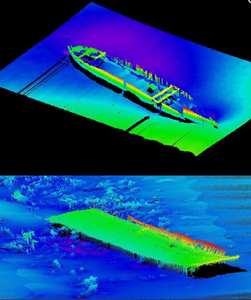
The Allen Reef Liberty Ship (above) and Casino Magic Barge (below) are examples of seafloor targets researchers can map using multibeam sonar. The sunken vessels are part of fish havens in the northern Gulf of Mexico. (Photo credit: Ian Church, Lauren Quas)
Her Work
Lauren operates a multibeam sonar to map the seafloor’s appearance and depth and quantifies the grain size of sediments using acoustic backscatter (a sound wave’s intensity after hitting the seafloor and returning to the sonar). A higher intensity return indicates that the seafloor sediment has large grain sizes, while a lower intensity return means it is composed of small grain sizes. She also collects sediment samples during research cruises using a sediment multi-corer, which removes the top 5 – 10 cm of sediment from the seabed. The sediment samples are brought back to her team’s lab at Stennis Space Center, where she analyzes them for grain size.
Lauren correlates the grain sizes depicted in the multibeam sonar data with the laboratory grain analyses to graph where different sediment sizes are located. Her sediment and backscatter data are important inputs for CONCORDE’s ocean models, which incorporate physical, chemical, and biological field data. Future scientists and responders will be able to use these models to predict and interpret how future oil spills could impact the northern Gulf of Mexico.

Lauren uses a multicorer like this one to collect seabed sediment samples. (Photo credit: CONCORDE)
Her Learning
Lauren’s first research cruise began two months after she entered her Hydrographic Science program. She recalled being intimidated at jumping into field work because of her limited background in hydrography. However, Dr. Church used the first leg of the cruise to teach her about the equipment and data processing programs, and Lauren then taught another student how to do so. “The knowledge I gained within such a short time is all due to the opportunities provided to me by Dr. Church and the CONCORDE project,” said Lauren. “This consortium is full of some of the most incredible, hard-working people I have ever met. It has been incredibly valuable to me as a young scientist to watch and work with this team.”
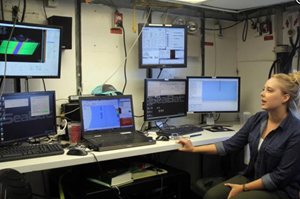
Lauren describes how the multibeam sonar transmits real-time bathymetry data to the computers onboard the R/V Point Sur. (Photo credit: Alison Deary, Carla Culpepper, and Kelia Axler)
Her Future
Lauren hopes to complete her master’s degree in August 2017 and begin her career as a field hydrographer. “The world’s oceans need to be mapped and I want to have a part in that,” said Lauren. “I am excited about the advances in technology.” She recommended that students considering a career in science get hands-on experiences to discover their passions. “I started out as a geologist, and now I am a hydrographer. If you have an interest, get your hands dirty. Volunteer or find an internship. You need the fundamentals taught in the classroom, but there is nothing like experiencing what a day in the life of a scientist is like.”
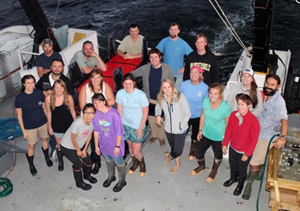
Lauren (center, gray jacket) and the CONCORDE field team onboard R/V Point Sur for the consortium’s Spring Campaign. (Provided by Lauren Quas)
Praise for Lauren
Dr. Ian Church described Lauren as an intelligent, hardworking, and innovative student whose eagerness to assist and teach others has made her a mentor to her peers. He emphasized the determination and problem-solving skills she exhibited in her leadership role aboard the R/V Point Sur during CONCORDE’s recent seabed mapping campaign. Lauren oversaw the successful mobilization of vessel sonar equipment, system troubleshooting, calibration, and data acquisition, processing, and analysis, which Church called “an incredible and notable accomplishment for anyone, let alone a graduate student with less than a year’s experience.”
Church said that Lauren’s enthusiasm is contagious and she takes pride in her research. “She is a naturally talented researcher with a drive to discover and produce innovative solutions to complex problems – I could not think of a person more deserving of the GoMRI Scholar award.”
The GoMRI community embraces bright and dedicated students like Lauren Quas and their important contributions. The GoMRI Scholars Program recognizes graduate students whose work focuses on GoMRI-funded projects and builds community for the next generation of ocean science professionals. Visit the CONCORDE website to learn more about their work.
************
The Gulf of Mexico Research Initiative (GoMRI) is a 10-year independent research program established to study the effect, and the potential associated impact, of hydrocarbon releases on the environment and public health, as well as to develop improved spill mitigation, oil detection, characterization and remediation technologies. An independent and academic 20-member Research Board makes the funding and research direction decisions to ensure the intellectual quality, effectiveness and academic independence of the GoMRI research. All research data, findings and publications will be made publicly available. The program was established through a $500 million financial commitment from BP. For more information, visit http://gulfresearchinitiative.org/.
© Copyright 2010- 2017 Gulf of Mexico Research Initiative (GoMRI) – All Rights Reserved. Redistribution is encouraged with acknowledgement to the Gulf of Mexico Research Initiative (GoMRI). Please credit images and/or videos as done in each article. Questions? Contact web-content editor Nilde “Maggie” Dannreuther, Northern Gulf Institute, Mississippi State University (maggied@ngi.msstate.edu).
